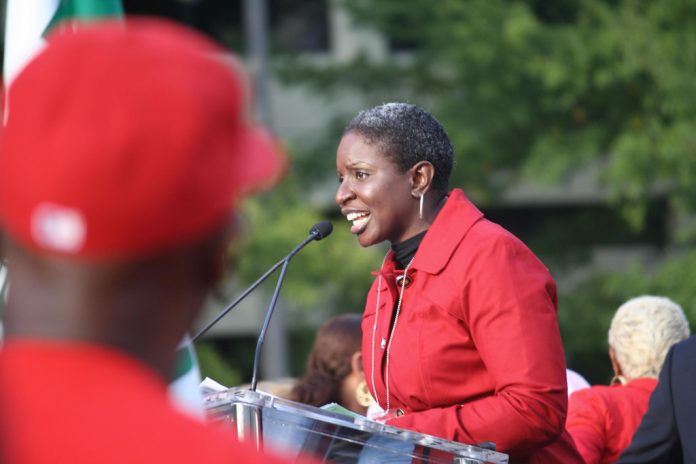
Teachers unions don’t benefit educators; they are basically political action committees, says Larry Sand.
Educators don’t get much for their $1,200 yearly dues.
In the aughts, after blindly being a dues-paying National Education Association member for years, I opened my eyes, and discovered that I’d been wasting my money. The teachers unions were primarily about politics, all of which went in a leftward direction. One in-your-face example at the time was at the Democratic Convention in 2008, where NEA president Reg Weaver spoke. His opening words were, “I am here today on behalf of 3.2 million NEA members to tell you why we support Barack Obama for President of the United States.” It sounded as if all 3.2 million members of the NEA were backing Obama. Then in his last sentence, he left no doubt. “That, my friends, is why the 3.2 million members of the National Education Association are organized, energized and mobilized to help elect Barack Obama as the next president of the United States of America.”
Nothing has changed since then. Current NEA boss, Becky Pringle, speaking before a House Committee, blamed a “radicalized Supreme Court” for its decision to “unravel abortion rights, undermine the “separation of Church and state,” and also insisted that educators would “tirelessly fight for the rights of LGBTQ+ students and educators.”
At the latest NEA convention in July, the New Business Items (messages of concern from the hoi-polloi to the NEA aristocracy) are telling. While some noxious NBIs were voted down, many were passed. For example, NBI 39 states, “The NEA will demonstrate its support for the right to asylum for migrants from Venezuela and Central America now arriving at the U.S. southern border.” NBI 41 has the NEA “taking all necessary steps to defeat and overturn the ‘Don’t Say Gay’ law in Florida and other homophobic and anti-transgender laws and attacks throughout the country.”
And then there is NBI 15 which directs the NEA to “compile research to create fact sheets about the largest 25 organizations that are actively working to diminish a students’ right to honesty in education, freedom of sexual and gender identity, and teacher autonomy. These fact sheets should include, but not be limited to, information about these organizations’ funding sources, their leaders within the organizations, connections to known entities that are seeking to dismantle public education….” So the union will be engaging in opposition research and creating an “enemies list” of groups that don’t buy into the NEA’s leftwing agenda. This exercise will cost union members – left, right and center – $140,000.
As Brenda Lebsack, teacher and former school board member, notes, “…as I read the 70 new business items and 40 amendments of bylaws, legislation, and resolutions, and listened to the platform speeches, it was obvious the NEA only represents those who hold the same ideologies and radical leftist political views.” She adds, “Its priorities were apparent, because of the 110 motions discussed and voted on, only four remotely addressed student academic achievement.”
The American Federation of Teachers convention, also held in July, was no less politically infused. The union agreed to call for a “week of action for reproductive freedom” in September to mobilize members “to participate in teach-ins, sit-ins, walk-ins, and other rallies and demonstrations.” The AFT will also urge boards managing the retirement funds of members to divest assets from corporations that “extract, transport, trade, or otherwise contribute to the production of coal, oil, and gas. Additionally, diversity, equity and inclusion (DEI) was peppered throughout various resolutions.
But mostly, the convention was all about Randi Weingarten – AFT’s supreme leader and most vocal lobbyist – who said many outrageous things. Before the convention began, she tweeted the results of a poll which shows that “nearly 9 out of 10 teachers say schools have become too politicized.” Not realizing that she’s a big part of the problem, Weingarten claimed, “AFT members were on the frontlines of the first wave of the pandemic, but in many ways the last year was even harder” due to “mask wars, culture wars, the war on truth, or the devastation in Uvalde.”
This has become a persistent theme for Weingarten. In a June press release titled “Educators are at a breaking point,” She said that “teaching has never been an easy job” but the added stress of “the injection of politics into our classrooms has done a real number on our educators.” Talk about projection! As the American Enterprise Institute’s Robert Pondiscio and RJ Martin note, Weingarten’s comments about the politicization of education would be far easier to stomach if she practiced what she preached. Instead, “she routinely utilizes her perch atop America’s second-largest teachers union to opine on virtually every political topic imaginable. For instance, on June 30 Weingarten slammed the ‘extremist right-wing majority’ on the Supreme Court for changing how the EPA regulates greenhouse gas emissions. Six days earlier, she thundered that Roe V. Wade was overturned by ‘extremist judges’ and was ‘a threat to freedom everywhere.’ A day earlier, Weingarten released yet another statement attacking conservative justices for ‘callously and cravenly imposing its view of who has rights’ after they struck down a New York gun control law.”
Weingarten has also urged parents and teachers to vote against politicians who are focused on things like “book banning, culture wars and injecting division into our classrooms, rather than investing in mental health resources, literacy programs and efforts to reduce class sizes.”
Additionally, Weingarten was instrumental in keeping schools shuttered during the time of Covid, even influencing CDC policy on the subject. She has also denied the existence of Critical Race Theory in schools, while having Ibram X. Kendi, probably the most vocal and aggressive CRT proponent in the country, speak at an AFT conference. His talk was touted as, “Hear from Dr. Ibram X. Kendi in this free-ranging discussion with student activists and AFT members on his scholarship and on developing anti-racist mindsets and actions inside and outside classrooms.”
When Weingarten wasn’t talking at the AFT shindig, politicos like Sen. Elizabeth Warren and radical “Squad” member Ayanna Presley took the floor.
After wading through all the leftwing blather, I can’t help but wonder why any conservative, libertarian, right-leaning, centrist or apolitical teacher would continue to belong to a teachers union. In California, when a teacher joins a local union, she typically forks over about $1,200 yearly. If the union is an NEA affiliate, $768 will go to the California Teachers Association and $204 will be sent off to NEA command central in D.C. The remaining $200 or so stays at the local level. Much of the money that goes to CTA/NEA is spent on leftwing politics, and every penny of the unions’ income is tax-free.
Fox News, citing OpenSecrets.org, reports that donations from the two national teachers unions have long been on the rise and grew from $4.3 million in 2004 to more than $32 million in 2016. The data also show that in preparation of the 2022 midterms, the two teachers unions have so far provided $1.3 million to Democrats and a scant $2,500 to Republicans. Also, as reported by the Americans for Fair Treatment, the NEA in 2020-2021 spent more than twice as much money on politics-related expenditures than on its membership.
It’s important to note that many people assume that a great majority of teachers are on the left, so the spending is justified. But this is false. NEA President Reg Weaver stated in 2005 that one-third of the NEA is Republican, one-third Democrat and one-third “other.”
Additionally, Mike Antonucci has written that NEA members lean no further to the left than any other large group of Americans. “The national union conducts periodic internal surveys to ascertain member attitudes on a host of issues. These surveys are never made public, and results are tightly controlled, even within the organization. The 2005 NEA survey, consistent with previous results, found that members “are slightly more conservative (50%) than liberal (43%) in political philosophy.”
More recently, a 2017 EdWeek poll found 43% of teachers described themselves as politically moderate, 29% as liberal, and 27% as conservative.
So what do the unions do that actually benefits teachers?
Some teachers may argue that the union will help them get a job at a certain school. But as Stanford professor Caroline Hoxby explains, collective bargaining agreements (CBA) stifle any management flexibility in determining the best slot for a teacher at a given school, as well as denying schools the opportunity to get rid of underperformers.
Good teachers especially are hurt by union CBAs. “Wage compression” occurs when the salaries of lower paid teachers are raised above the market rate, with the increase offset by reducing the pay of the most productive ones. Mike Petrilli of the Fordham Institute takes it one step further, claiming CBAs hurt the bottom line of all teachers. According to Petrilli, “Teachers in non-collective bargaining districts actually earn more than their union-protected peers – $64,500 on average versus $57,500.” Petrilli’s study was from 2011, and research from Michael Lovenheim in 2009 and Andrew Coulson in 2010 bore similar results. Also, University of California San Diego professor Augustina Pagalayan reported in 2018 that CBAs do not improve teacher pay.
The unions also like to instill fear into teachers about their post-union life, and too many teachers buy into it lock, crock and barrel. A national poll commissioned by the Teacher Freedom Project in 2019 showed that many teachers have no idea about their professional benefits. Almost a third erroneously assumed that they would not be covered by their union’s CBA should they quit. Almost a quarter thought that they’d lose their tenure protections, and 18% said they’d lose their health insurance – all untrue. The unions either foster or ignore teacher ignorance on these matters. Also, while 70% of teachers understood that they would lose their liability insurance provided by the union should they leave, few are aware they could join the Association of American Educators or Christian Educators Association International – professional organizations – and get better coverage at a much lower cost.
The Janus ruling in 2018 means teachers don’t have to pay any money whatsoever to a union, and there is no reason to belong to one unless you are a happy being an ATM for union honchos’ pet leftist candidates and causes. Something to ponder for the majority of teachers who have been blindly propping up the teachers unions to their own detriment.
Originally published by For Kids & Country. Reprinted with permission of the author.
For more School Reform News.










Same idea: https://radiofreeoxford.com/2022/08/02/what-do-the-poison-apple-endorsements-cost-maryland-students/?amp=1